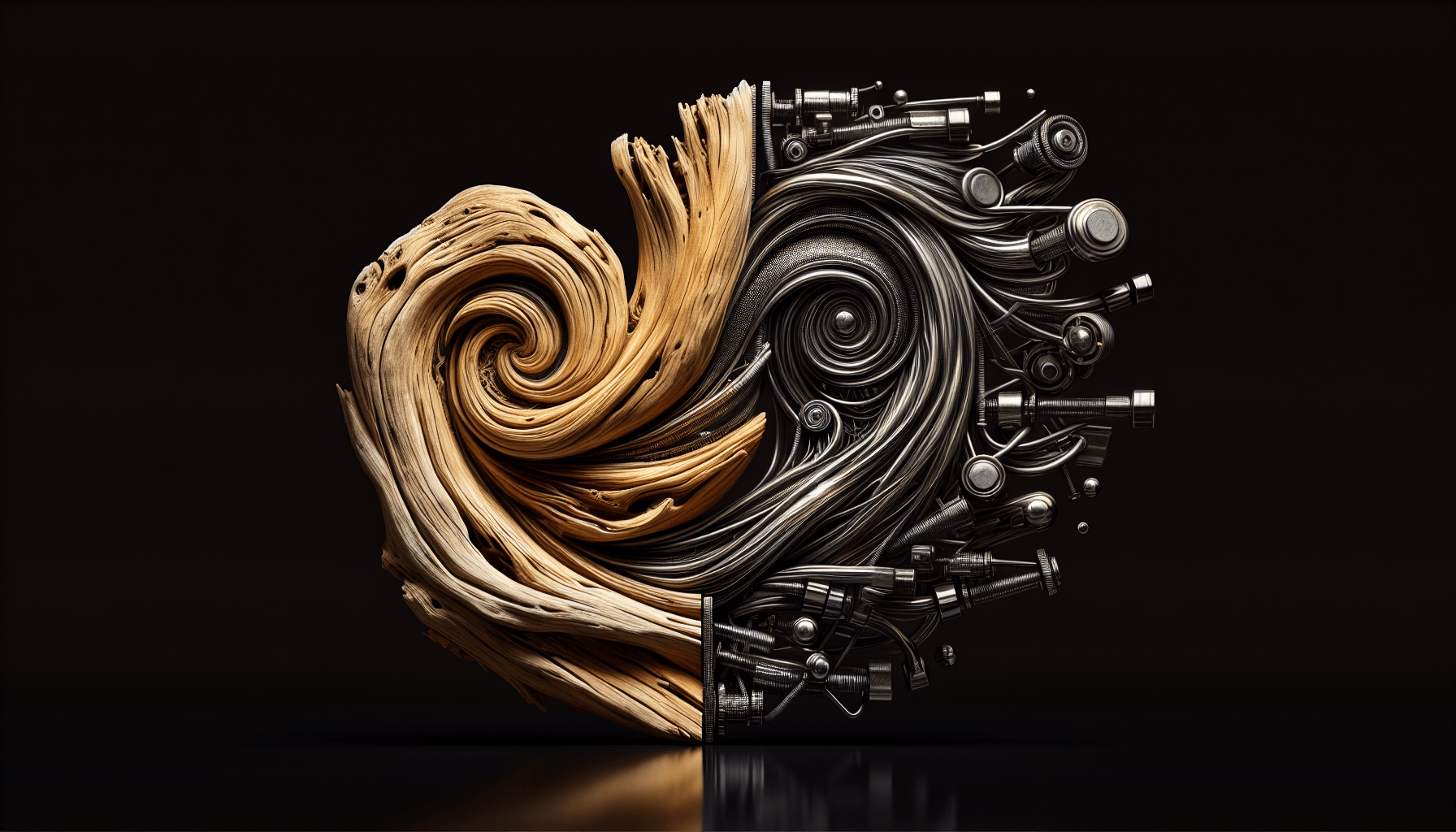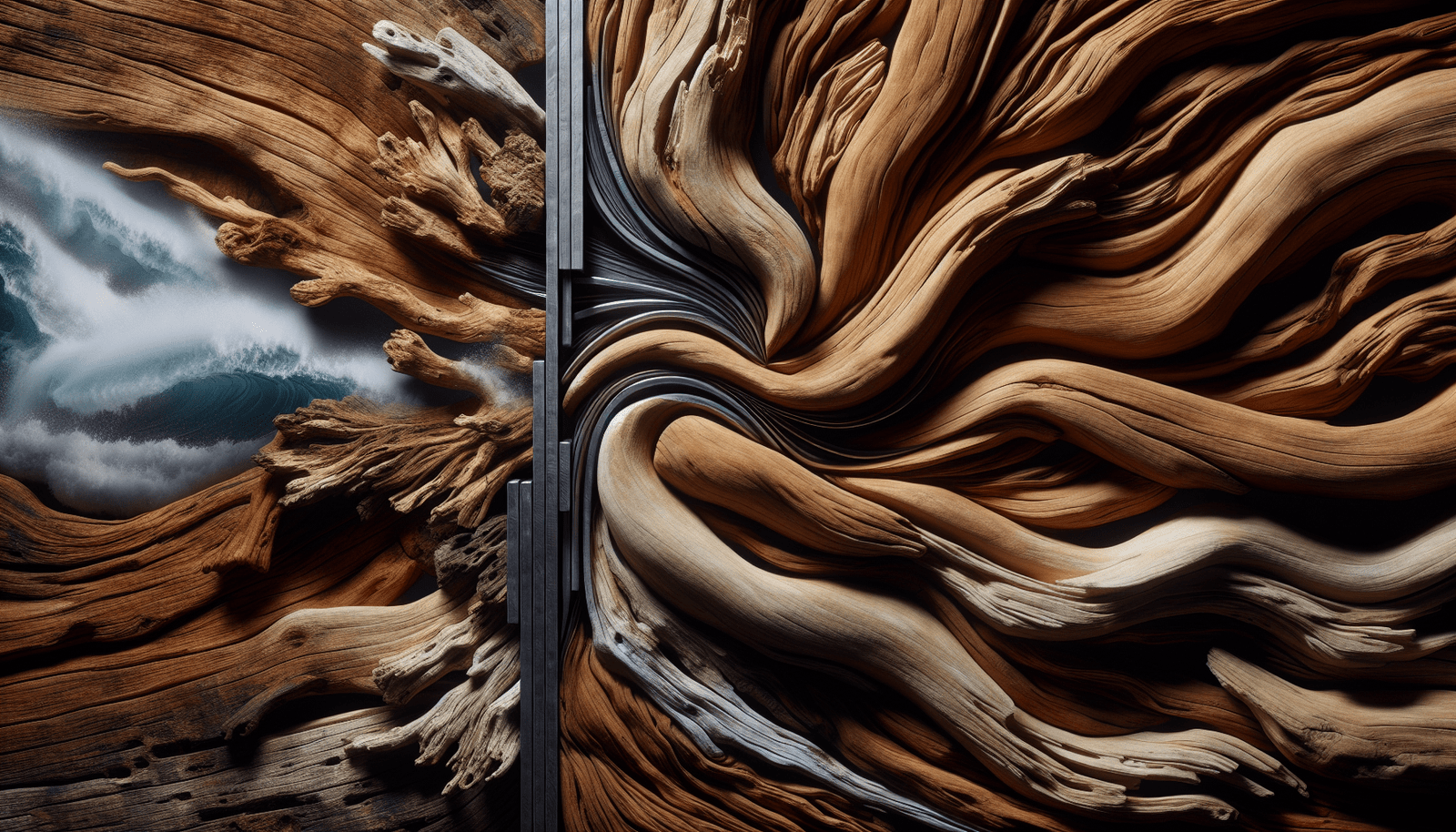Have you ever been strolling along the beach and stumbled across a beautifully aged piece of wood, sun-worn and smoothed by the ocean’s embrace? This piece of driftwood, a testament to time and nature, may evoke a curiosity about its journey and its potential transformation into something extraordinary, such as driftwood metal. Curious about what driftwood metal is and how these two seemingly different elements come together? You are not alone.
As we journey through the fascinating world of driftwood metal, you will uncover the harmonious blend of natural textures and industrial elements. This captivating fusion results in unique pieces that elevate both art and function.

Understanding Driftwood
Driftwood, at its essence, is wood that has been washed onto a shore by the actions of wind, waves, or other forces of nature. This wood has traveled across oceans, tumbled through storms, and embraced the smoothness that only years of oceanic movement can bestow.
The Journey of Driftwood
Driftwood starts its existence as fallen branches or trees along riverbanks or coastal forests. Logs and branches are carried by rivers into vast oceans, where they begin their journey. Over time, the relentless tides and salty waters strip the wood of its bark. The result is a stunning textural quality. Each piece becomes a natural sculpture with curves, bends, and a smooth finish that only time can create.
The Ecology of Driftwood
Driftwood is more than just a testament to nature’s artistry; it plays a vital ecological role. It provides shelter and nurseries for marine life, offering protection in its crevices. Birds and sea creatures find it as a source of refuge and food. Driftwood is an integral part of the coastal ecosystem.
The Allure of Metal
In contrast to the natural process of driftwood, metal is a product of human ingenuity. Metals are elements that, when polished or engineered, offer a strength and industrial appeal desirable in many applications, from construction to art.
Types of Metals Used with Driftwood
The metals paired with driftwood often include:
- Steel: Known for its strength and durability, steel brings a sleek modern feel when juxtaposed against the organic texture of driftwood.
- Copper: With its warm, inviting tones, copper complements the earthy qualities of driftwood while adding richness and elegance.
- Aluminum: Lightweight yet robust, aluminum allows for flexibility in design, adding contemporary touches to driftwood creations.
These metals each bring their own visual and functional qualities to driftwood art and crafts, making each creation unique.
Driftwood Metal: The Fusion
Driftwood metal is where the organic meets the industrial, crafting a hybrid that captures the essence of nature complemented by human design. This fusion often results in stunning pieces of furniture, artistic sculptures, and various home decor items.
The Art of Combining Driftwood and Metal
The craftsmanship required to combine these elements demands a deep understanding of both materials. The artisan must respect the natural form and beauty of the driftwood while crafting metal elements to fit and bolster the piece. This balancing act creates harmony, allowing each material to shine.
Applications of Driftwood Metal
Pieces crafted using driftwood metal can vary greatly, offering both decorative and practical uses:
- Tables and Chairs: Furniture that showcases the juxtaposition of materials, often featuring driftwood bases with metal-framed surfaces.
- Sculptures: Art pieces that highlight the unique shapes of driftwood enhanced by metal designs, providing both contrast and support.
- Lighting Fixtures: Driftwood pieces that serve as the foundation for lamps and chandeliers, incorporating metal for structure and style.
Decorating with Driftwood Metal
Adorning your home with driftwood metal pieces can transform any space by adding an element of nature balanced with industrial chic. Whether subtle or bold, these pieces can become conversation starters that elevate the aesthetic of any room.
Choosing the Right Piece
When selecting driftwood metal pieces, consider the scale and existing style of the space. A large driftwood metal dining table may serve as a centerpiece, while smaller sculptures can add interest to a mantle or shelf.
Caring for Driftwood Metal Pieces
Proper maintenance ensures your driftwood metal art retains its charm. For driftwood, dusting with a soft cloth is usually sufficient. For metal parts, use a gentle cleaner to preserve its luster and prevent tarnishing. Regular maintenance will help in preserving the integrity and beauty of your pieces.

The Environmental Aspect
The crafting of driftwood metal can also embrace sustainability. Using driftwood minimizes wood waste, and reclaimed or recycled metals can enhance this eco-friendly approach. This aspect not only supports environmental consciousness but also allows artisans to be resourceful and creative in their methods.
Sustainable Practices
Artisans focused on sustainability may seek certification or partnerships that ensure their materials, both wood and metal, comply with environmental standards. This commitment can be an essential part of selecting pieces for your home, knowing that they contribute to a healthier planet.
The Cultural Significance
Driftwood metal art often carries cultural meanings, embodying themes of resilience, transformation, and balance. The journey of driftwood across the sea can represent life’s path, with the incorporation of metal highlighting technological advancement and human impact.
Artisans’ Inspirations
Artisans often draw inspiration from the natural landscapes around them, translating natural beauty into their designs. Their works may draw upon local scenery, history, or personal experiences, bringing depth to each piece.
Investing in Driftwood Metal Art
For collectors or enthusiasts, driftwood metal art can be a valuable addition. The uniqueness of each piece coupled with the skill involved in creating them can make these items both personal treasures and financially wise investments.
Evaluating Authenticity and Craftsmanship
Evaluating driftwood metal pieces involves recognizing quality craftsmanship and authentic materials. Reputable artisans or galleries should provide transparency about the origins of the materials and the artistic process. Understanding these elements helps in appreciating the intricacies and the value of the piece.
Conclusion
In combining the worn beauty of driftwood with the robust utility of metal, driftwood metal offers a unique blend that celebrates nature and design. These pieces stand as beautiful reminders of the harmony between organic elements and industrial materials. Understanding this blend of natural and human-made elements invites you to see not just art, but also the inherent story each piece tells, enriching both personal spaces and collective narratives alike.